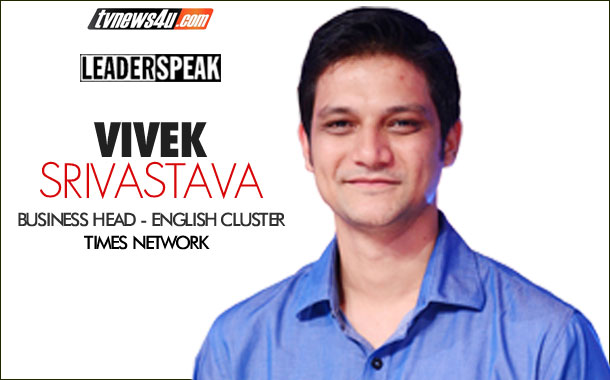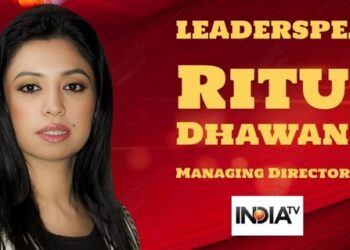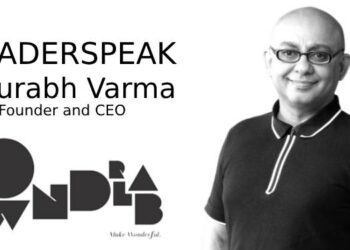This time round in LEADERSPEAK, TVNEWS4U.COM is delighted to bring you some learnings and insights from the professional journey of a young veteran, Vivek Srivastava – Business Head of the English Cluster of channels at the Times Network.
In conversation with Chief Mentor – TVNEWS4U.COM, Srivastava takes us through his early-days number-crunching to being part of the launch team of one of India’s biggest recent successes in the Hindi General Entertainment Television space, to present-day business leadership of a genre-leading cluster of TV channels in English — a language that drives aspirations across India.
Srivastava was a young Lucknow boy when he arrived in Mumbai when he was only in the 9th standard, and stayed on to blaze a high-performance career as a respected leader in the business of Media & Entertainment.
Enjoy the conversation. – Chief[email protected]
Tell us something about yourself, especially education and early days as a professional…
I’m a Lucknow boy. I came to Bombay when I was in my 9th standard; dad got transferred here. My schooling and college was here. I did my BSc in Statistics from Bhavan’s College, then went on to do my Management in Marketing from Mumbai University. Between this I worked with IRMB for a year in the research division. I was a research assistant helping analyze data. After my management I joined Television Audience Measurement (TAM).
I joined their broadcasting consultancy, the S Group, and that really was the founding space for me where I got most of my learnings, because TAM has this beautiful thing which allows you to go deep and wide and as it was an agency producing data you had to go very deep and look at numbers effectively. You were a consultancy and were meeting broadcasters, especially people at very senior levels. The problems thrown to us were largely business problems. Therefore there was a very nice mix of macro and micro.
What kind of business problems would come at you?
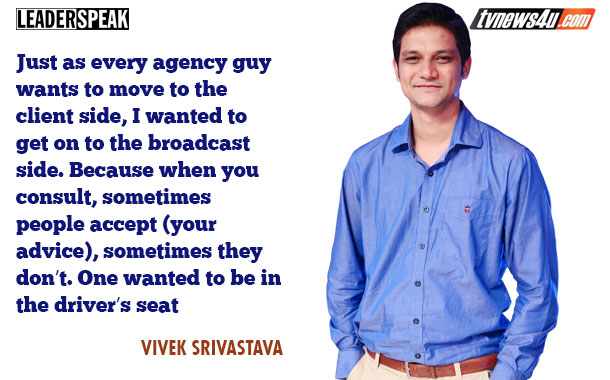
There could be from very small things like how should I plan my promos for a GEC (general entertainment channel) to things like my sales are going down despite the fact my numbers are good to how can I get to represent myself better in the right cluster set. The good part was there was always a business problem which preceded the understanding of data. Therefore it was not just about the fact that I want to get greater viewership in this day part; it was more about this is my division… these are my business challenges — and specifically when you meet people at the top they come at you with a very macro outlook – and what can I do to circumvent it. How can I better myself, how can we become leaders… Sometimes when you talked to leaders, it was how should we grow from where we are, and that’s the beauty about talking to leaders: when you talked to the guys who had a majority of the share, they would want to go from an 80 percent share to a 90-95 percent share, or from a 30 percent share to a 40, 45 percent share.
So that experience at TAM was really like a foundation stone.
…and you were at TAM for slightly under five years. That’s an advantage that few broadcast vertical heads have today…
(Smiles) I would assume that there are people with equal or greater intelligence in the marketplace. But yes, from my personal standpoint my experience at TAM was a great learning for me.
Just as every agency guy wants to move to the client side, I wanted to get on to the broadcast side. Because, you know, you consult, sometimes people accept (your advice) sometimes they don’t. One wanted to be in the driver’s seat.
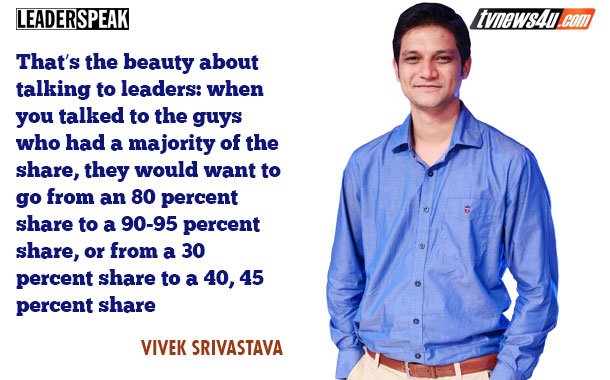
And that was when you joined Viacom…
Yes. It was in Jan 2008 that I joined them. They were launching a Hindi general entertainment channel (Colors).
So who reached out to you from there?
Oh HR… I also knew Mr (Rajesh) Kamath from earlier… and a few other people. The great thing about Viacom was one, it was a startup, and there was great leadership. I’ve been fortunate to have had very good bosses; great bosses, actually, who have given you the autonomy to do what you want to do, and also the guidance to guide you in the right direction.
I joined in the research department and then went on to look after a whole host of other functions. I moved from research to marketing, marketing to business — commercial and business planning and went on to international business and domestic distribution and then came back to look after digital and commercial. It was about seven-odd years.
Colors was a great learning ground primarily because it was a startup and because the team was extremely hungry to deliver. And we became successful, obviously, and grew at a pace which was faster than we could have imagined. Therefore a lot of strategizing was at a fast pace and I think the beauty of Colors’ success was that it was not stroke of luck, it was extremely meticulous planning – plan A, plan B, plan C. We had our fair share of success and failures, and an important thing that Colors taught me was that if you have a failure, you should have a backup plan. It was a great place for opportunities, which it gave me and my peers a lot of.
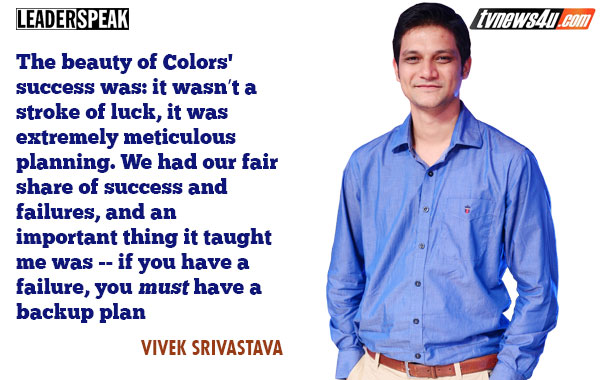
What kind of career growth did you have there?
I joined them as a senior manager, I left them as a vice president.
That’s a great growth curve. And it wasn’t just one function. You moved from one to the other, and in a logical sequence…
Yes, and that’s why I’m grateful to that company because it gave me the opportunity to grow and move from function to another; otherwise you are a specialist in just one space. I think it has a bit to do with the company culture, the leaders, and the fact that it was a startup and startups typically give you the opportunity to work in multiple functions and become as we call it the multiple plug point.
… it also has a lot to do with personal knowledge, experience, capability …
…well, and a lot to do with the fact that there were people who ensured that you go that exposure. You had to do a lot with exposure.
When Colors was being launched, there were already two new or recent GECs in the market – if memory serves me right, 9X had reached 100 GRPs by the end of three months…
…and there was (NDTV) Imagine…
…yes, there was Imagine too. So it was already a cluttered marketplace, with two recently launched brands leading the noise and the established leaders having upped the marketing ante. In that atmosphere, what was Colors’ launch strategy?
From a strategy standpoint, where Colors stood out was, it had an equal impetus on fiction and non-fiction. The fact that you had a fear factor and a Bigg Boss, both of which did well, that Balika Badhu, Jai Shree Krishna became case studies… the fact that everything that was launched after Bigg Boss – Uttaran and Laado… became successful. The key to success was the integration between Bharat and India. The fiction part was Bharat, which is very well entrenched (in society). And the aspirational India, which is Bigg Boss… Fear Factor — the new-age and the aspirational, that was one big part.
The other big thing that happened was we took competition head-on. When everybody said let’s not fight with Kyunki… and Kahani…, we went ahead and put our biggest properties and put them against those shows. So Fear Factor, which was launching on week days, we put it against Kyunki and Kahani. It was a great success. And the fact that we had leaders like Rajesh Kamath and Ashwini, who understood the space extremely well, and ensured that we moved fast within the space. I think that was the success mantra.
Yes, indeed. At the same time, I have a theory. Actually, Colors might have taken a leaf out of the launch book of Sony Entertainment Television. When it launched way back on 8th October 1995, Sony came up with what then was the worst nightmare of any Hindi GEC Marketing Head. Those were the days of weekly shows, so it was that much more difficult to build affinity and loyalty appointment viewing that a good daily, well-promoted, can garner comparatively that much more easily. And one remembers that Sony launched with some great titles like Aahat, which, while it later became the top Hindi show on GECs across several years, still received only 0.2 or a 0.3 TRPs every original weekly telecast. The content was top notch at launch too, but the problem was, Aahat as a show was not making enough noise to cut the marketing clutter. See, there were at least 25 weekly shows Mondays to Fridays that marketing had to make seen, noticed, viewed and hopefully followed, but with 25 properties to promote each week, the clutter was immense, because every other GEC was doing the same thing. So by end-October, Sony, seeing that Lata Live The Queen in Concert, Lata’s first live performance in perhaps a couple of decades in India, was available, they went after it. And Sony then bought the rights to that telecast, and promoted only that upcoming concert across all the media on their plan, drumming up intense, frenzied anticipation for the show. It was classic Movie marketing, pushing the maximum footfalls to the ‘theater’, which was the TV set, and then, within that live event, they cross promoted only two fiction shows – one was B P Singh’s Aahat, and the other was Pavan Kaul’s Kaash – a thriller and a soap respectively. While Kaash failed, the ratings of Aahat broke through the ceiling!
What I’m getting at the end of perhaps the longest ever question in any media interview, is: One feels Colors emulated the Sony strategy and at launch itself, invested massively into Fear Factor, with Akshay Kumar, stupendous locations, budgets, great gripping format and content, and only promoted that non-fiction tent pole running up to the launch. And then, within the telecast of Fear Factor, one of the shows it cross promoted intensively, was Balika Badhu. Of course, that show had brilliant content and casting, but the strategy helped put the little vulnerable Balika from the show into the limelight, and the empathy drove appointment viewing and, thereafter, loyalty because of the excellent content.
So was Colors perhaps inspired by the Sony strategy? Please comment – in a length at least equal to or longer than the question J
(Laughs) Not this particular case study, I wasn’t aware of this, but the thought was pretty much the same. We had the iceberg theory which is, you know, people will come for (the top of) the iceberg, which is your non-fiction shows, and they will stay for the bottom of the iceberg which is much bigger, which is your fiction shows. So we always had that thought – to have those biggies to kick off, and yes of course you always wanted to cross promote your fiction and non-fiction shows, otherwise what’s the point… So, get one person to change to our channel and then get everybody else (in the family) to watch the other shows too.
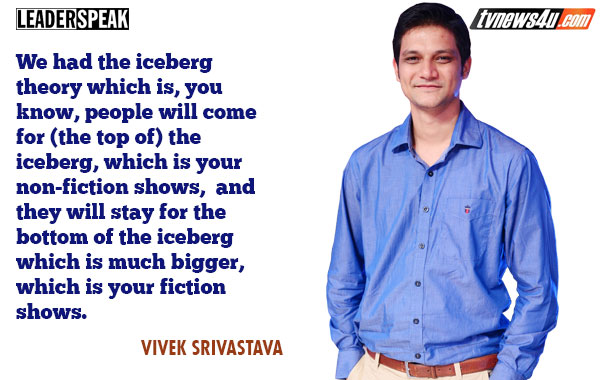
Absolutely. So, from Colors and Hindi GEC, you moved to the English Cluster at the Times Network. How did that happen.
I’ve known Anand for some time, and he was kind enough to call me when there was an opportunity here. And it obviously was a good opportunity, so I took it with both hands and here I am (smiles). It’s as simple as that.
You joined here in late 2014, right?
October 2014. So it’s been around a year and eight months.
The English entertainment genre – Movies and GEC – in India is sold more on perception than on numbers and ratings, right?
Mmmm, yes and no. I think English Movies, per se, are completely ratings-driven. Movies is the most mass genre in the English entertainment space. Whenever a viewer (while watching television) switches watching from Hindi to English, the first piece of content that he explores is in the English Movies space. And I think that is true for most of us. I remember watching a Home Alone, and then, because your parents and others are there, you move to news, and infotainment, and English entertainment, and music… So movies are really a mass spectrum, and there is a viewership, a very consistent viewership, which exists. We realize that, and I think the data has always been sensitive to good quality content in the English space.
What was the situation like when you joined to head the English Cluster at the Times Network?
Well, we had been the new kid on the block, and when we started off. We (Movies NOW) had had a spectacular launch – for the first year, we were Number One. We slipped to Number 2 in the second year, and went on to be the Number 3 and 4 player in the subsequent years; we missed a few tricks as far as distribution was concerned.
When I joined, a whole host of the team was getting changed, and everyone was focused on ‘how can we make the small delta changes which can lead to a sigma impact on every aspect of the business’. And that’s what we did – starting from distribution to content acquisition to scheduling to marketing. All the things we did were small delta improvements.
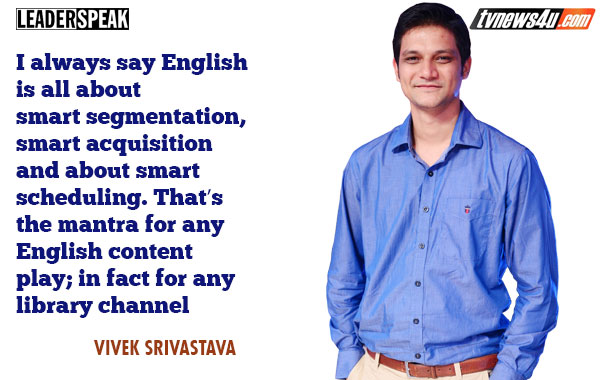
I always say English is all about smart segmentation, smart acquisition and smart scheduling. That’s the mantra for any English content play; in fact for any library channel.
We possibly understand the space the best — maybe it’s (because) the group’s largely been present in the space for a long time, therefore from the Board (of Directors level) to down, it’s in the DNA to understand the space much better than everybody else. Also the fact that the team here has worked extremely well. If you look at the space, Movies NOW was very different from everything else when it launched. It did not launch with the premiere strategy – they went ahead and bought the second runs. And succeeded with the second runs.
Why did they go with second runs? Was it only a cost implication?
Well, it might have started as a cost implication, but there also was a viewership logic to it. Hollywood movies have started making as much money (on theatrical releases in India) as they do only in the last three or four years. Around the time when Movies NOW was launched, there was very little marketing for movies, except or the top five or six movies each year, like the top franchises like a James Bond or a Jurassic Park
Apart from those big movies, nothing was marketed as well as it should have been. Therefore, the English movie channels were actually working as a marketing vehicle for these properties. You would come on to this channel, you would chance upon a movie and realize it’s a great movie, you would watch it again, then again. Till you realize it’s a great movie. And you realize, hey, Vin Diesel is a great star! I don’t think apart from Fast And Furious any other Vin Diesel movie has ever been promoted. That too part 7 only. I don’t think part 1,2,3 and 4 would have received any promotions. So that is one thing Movies NOW understood very well. What we pride ourselves on, in our setup, is that we understand Indian audiences very well.
The second thing we were very quick to realize was that the audience is evolving very fast, and especially with the advent of social media. You would have seen that earlier if you wanted news about your favorite star or movie you had to wait for your favourite Hollywood magazine or page-3 in the newspapers; that was your only source of information, or, for that matter, the E-Entertainment channel. Now, that information is available on social media in real time! You can go the Facebook page or Twitter account of your favourite star and trace where was he shooting, when and for what was he shooting, how is he promoting his film or work… so every bit of information is readily available at any given point in time.
Also, India was evolving very fast and a growing number of millennials were getting into the mix. A lot of people who were born in the late 80’s and 90’s, were educated and with English as a language, and who grew up with cable channels and watched a lot of English movies… they developed a liking and disliking for a particular type of content.
Therefore Romedy NOW was born. It was really the first segmented product in the English entertainment space. Prior to when Romedy NOW was launched, I think what was being generally dished out (in the English entertainment space) was like what I like to call the classic Gujarati thaali – you would have the achar, the masala, the puri, and a little of everything there. There was action, comedy, romance, thriller or horror, everything was there in that one thaali on that platform, and you would tell people watch whatever is available. We realized there’s a potential for this audience which has a specific need. And that need in the case of Romedy NOW is slice of life, it is Love, Laugh, Live, it’s just feeling happy about their space.
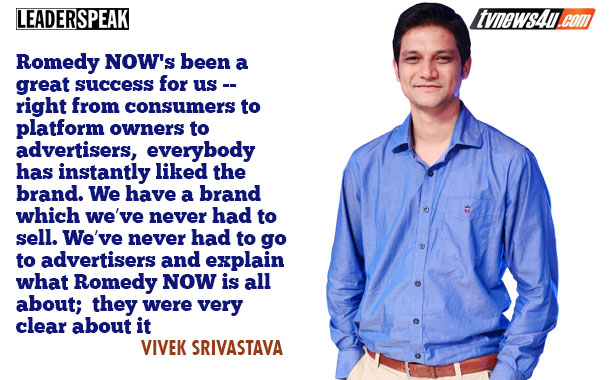
And Romedy has been a great success for us — right from consumers to platform owners to advertisers everybody has instantly liked the brand. We have a brand which we’ve never had to sell. We’ve never had to go to advertisers and explain what Romedy NOW is all about; they were very clear about it. Therefore, whether they buy it or they don’t buy it, they could have their reasons for it. But do they understand it? I don’t think there was ever any disconnect about understanding what Romedy NOW is.
(Editor’s Note: Romedy NOW had launched in September 2013 and in around a month it will complete three years. A year ago, at its two-year mark, within the short time of its launch, Romedy NOW had beaten many older channels in the genre to command a 58% share of the market, with as many as 18 out of the top 25 shows in the English GEC category being Romedy NOW offerings (BARC – All India 1Mn+ NCCS AB 15-50 Wk 21-25 of 2015.
The final part of this conversation touching upon the other channels of the English cluster and other topics, will appear next week)

